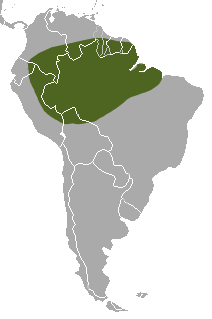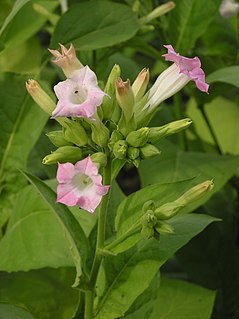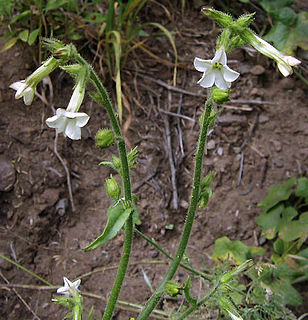
Nicotiana is a genus of herbaceous plants and shrubs in the family Solanaceae, that is indigenous to the Americas, Australia, south west Africa and the South Pacific. Various Nicotiana species, commonly referred to as tobacco plants, are cultivated as ornamental garden plants. N. tabacum is grown worldwide for production of tobacco leaf for cigarettes and other tobacco products.

Nicotiana glauca is a species of wild tobacco known by the common name tree tobacco. Its leaves are attached to the stalk by petioles, and its leaves and stems are neither pubescent nor sticky like Nicotiana tabacum. It resembles Cestrum parqui but differs in the form of leaves and fusion of the outer floral parts. It grows to heights of more than two meters.

Nicotiana sylvestris is a species of flowering plant in the nightshade family Solanaceae, known by the common names woodland tobacco, flowering tobacco, and South American tobacco. It is a perennial plant in the tobacco genus Nicotiana, native to the Andes region in Argentina and Bolivia, in South America.

Nicotiana rustica, commonly known as Aztec tobacco or strong tobacco, is a rainforest plant in the family Solanaceae. It is a very potent variety of tobacco, containing up to nine times more nicotine than common species of Nicotiana such as Nicotiana tabacum. More specifically, N. rustica leaves have a nicotine content as high as 9%, whereas N. tabacum leaves contain about 1 to 3%. The high concentration of nicotine in its leaves makes it useful for producing pesticides, and it has a wide variety of uses specific to cultures around the world. However, N. rustica is no longer cultivated in its native North America, as N. tabacum has replaced it.

Nicotiana alata is a species of tobacco. It is called jasmine tobacco, sweet tobacco, winged tobacco, tanbaku, and Persian tobacco.

The Amazon weasel, also known as the tropical weasel, is a species of weasel native to South America. It was first identified from a museum specimen mislabelled as coming from Africa, hence the scientific name.

Nicotiana benthamiana is a close relative of tobacco and species of Nicotiana indigenous to Australia.

Nicotiana tabacum, or cultivated tobacco, is an annually-grown herbaceous plant. It is found in cultivation, where it is the most commonly grown of all plants in the genus Nicotiana, and its leaves are commercially grown in many countries to be processed into tobacco. It grows to heights between 1 and 2 meters. Research is ongoing into its ancestry among wild Nicotiana species, but it is believed to be a hybrid of Nicotiana sylvestris, Nicotiana tomentosiformis, and possibly Nicotiana otophora.
Pituri is a mixture of leaves and wood ash traditionally chewed as a stimulant by Aboriginal Australians widely across the continent. Leaves are gathered from any of several species of native tobacco (Nicotiana) or from at least one distinct population of the species Duboisia hopwoodii. Various species of Acacia, Grevillea and Eucalyptus are burned to produce the ash. The term "pituri" may also refer to the plants from which the leaves are gathered or from which the ash is made. Some authors use the term to refer only to the plant Duboisia hopwoodii and its leaves and any chewing mixture containing its leaves.
Mark Wayne Chase is a US-born British botanist. He is noted for work in plant classification and evolution, and one of the instigators of the Angiosperm Phylogeny Group-classification for flowering plants which is partly based on DNA studies. In particular he has researched orchids, and currently investigates ploidy and hybridization in Nicotiana In 1998 he shared the Linnean Medal with Colin Patterson. In 2008 he was one of thirteen recipients of the Darwin-Wallace Medal, which was given every 50 years by the Linnean Society of London. Has been the Keeper of the Jodrell Laboratory and now is retired but still an horary research associate at the Royal Botanic Gardens, Kew. He is a fellow of the Royal Society.
Nicotiana tomentosiformis is a perennial herbaceous plant. It is a wild species of tobacco native to the Yungas Valley region in the eastern piedmont of the Andes Mountains, primarily in Bolivia.
Nicotiana otophora is a perennial herbaceous plant. It is a wild species of tobacco native to the Andes Mountains of Bolivia and Argentina.
Nicotiana occidentalis subsp. hesperis is a short-lived herb native to Australia.

Nicotiana attenuata is a species of wild tobacco known by the common name coyote tobacco. It is native to western North America from British Columbia to Texas and northern Mexico, where it grows in many types of habitat. It is a glandular and sparsely hairy annual herb exceeding a meter in maximum height. The leaf blades may be 10 centimetres (4 in) long, the lower ones oval and the upper narrower in shape, and are borne on petioles. The inflorescence bears several flowers with pinkish or greenish white tubular throats 2 to 3 centimetres long, their bases enclosed in pointed sepals. The flower face has five mostly white lobes. The fruit is a capsule about 1 centimetre long.

Nicotiana clevelandii is a species of wild tobacco known by the common name Cleveland's tobacco.
N. africana may refer to:

Nicotiana × sanderae is a hybrid of the tobacco species Nicotiana alata and Nicotiana forgetiana. It is the most common Nicotiana variety found and sold in the United Kingdom. Nicotiana × sanderae requires soft soil mixed with sand to thrive. The plant will grow to heights of 3 feet (0.91 m) and will give off a sweet scent in the evening, like most Nicotiana plants. Nicotiana × sanderae are not hardy against frost and will die if they come in contact with it. They withstand drought. Because of their size, N. × sanderae are used as a house or garden plant.

Dr Maarten Joost Maria Christenhusz is a Dutch botanist, natural historian and photographer.

Psychoactive plants are plants, or preparations thereof, that upon ingestion induce psychotropic effects. As stated in a reference work:
Psychoactive plants are plants that people ingest in the form of simple or complex preparations in order to affect the mind or alter the state of consciousness.












